#Javascript splice array
Explore tagged Tumblr posts
Text
JavaScript oferece várias funções nativas para manipulação de arrays. Aqui estão algumas das mais comuns e úteis:
1. **`push` e `pop`**:
- `push`: Adiciona um ou mais elementos ao final do array.
- `pop`: Remove o último elemento do array.
```javascript
let arr = [1, 2, 3];
arr.push(4); // [1, 2, 3, 4]
arr.pop(); // [1, 2, 3]
```
2. **`shift` e `unshift`**:
- `shift`: Remove o primeiro elemento do array.
- `unshift`: Adiciona um ou mais elementos no início do array.
```javascript
let arr = [1, 2, 3];
arr.shift(); // [2, 3]
arr.unshift(0); // [0, 2, 3]
```
3. **`concat`**:
- Junta dois ou mais arrays.
```javascript
let arr1 = [1, 2];
let arr2 = [3, 4];
let arr3 = arr1.concat(arr2); // [1, 2, 3, 4]
```
4. **`slice`**:
- Retorna uma cópia rasa de uma parte do array, sem modificar o array original.
```javascript
let arr = [1, 2, 3, 4];
let slicedArr = arr.slice(1, 3); // [2, 3]
```
5. **`splice`**:
- Adiciona/remova elementos de qualquer posição do array.
```javascript
let arr = [1, 2, 3, 4];
arr.splice(1, 2); // [1, 4]
arr.splice(1, 0, 2, 3); // [1, 2, 3, 4]
```
6. **`map`**:
- Cria um novo array com os resultados de uma função aplicada a cada elemento do array.
```javascript
let arr = [1, 2, 3];
let mappedArr = arr.map(x => x * 2); // [2, 4, 6]
```
7. **`filter`**:
- Cria um novo array com todos os elementos que passam no teste implementado pela função fornecida.
```javascript
let arr = [1, 2, 3, 4];
let filteredArr = arr.filter(x => x > 2); // [3, 4]
```
8. **`reduce`**:
- Aplica uma função a um acumulador e a cada elemento do array (da esquerda para a direita) para reduzi-lo a um único valor.
```javascript
let arr = [1, 2, 3, 4];
let sum = arr.reduce((acc, x) => acc + x, 0); // 10
```
9. **`find` e `findIndex`**:
- `find`: Retorna o primeiro elemento que satisfaz a função de teste.
- `findIndex`: Retorna o índice do primeiro elemento que satisfaz a função de teste.
```javascript
let arr = [1, 2, 3, 4];
let found = arr.find(x => x > 2); // 3
let foundIndex = arr.findIndex(x => x > 2); // 2
```
10. **`sort`**:
- Ordena os elementos do array e retorna o array.
```javascript
let arr = [4, 2, 3, 1];
arr.sort(); // [1, 2, 3, 4]
```
11. **`forEach`**:
- Executa uma função para cada elemento do array.
```javascript
let arr = [1, 2, 3];
arr.forEach(x => console.log(x)); // 1 2 3
```
Essas são algumas das principais funções de manipulação de array em JavaScript. Elas permitem realizar uma ampla gama de operações para trabalhar com dados de maneira eficiente e concisa.
0 notes
Text
JavaScript Array Splice Method: A Detailed Exploration
0 notes
Text
such a good javascript programmer that I have to look up the slice/splice/shift/pop array builtins every single fucking time
0 notes
Link
JavaScript splice() method is significantly handy, when it comes to add, remove, or replace items in an array.
0 notes
Text
Spaced repetition and trying to save the day.
Today didn’t go as I planned really. Between the light and wasting the afternoon, once again I feel like I could have done more with my time.
——————
I learned about functions within functions
In my JavaScript refresher
I learned that map creates a new array and splice modifies the existing array by specifying where to delete and how many items to delete. It then returns the deleted items as an array
I should sleep now
0 notes
Text
You can learn JavaScript easily, Here's all you need to get started:
1.Variables
• var
• let
• const
2.Data Types
• number
• string
• boolean
• nUll
• undefined
• symbol
3.Declaring variables
• var
• let
• const
4.Expressions
Primary expressions
• this
• Literals
• []
• {}
• function
• class
• function*
• async function
• async function*
• /ab+c/i
• 'string'
• ()
Left-hand-side expressions
• Property accessors
• ?.
• new
• new .target
• import.meta
• super
• import()
5.operators
• Arithmetic Operators: +, -, *, /, %
• Comparison Operators: ==, ===,!=,!==, <, >, <=, >=
• Logical Operators: &&, ||, !
6.Control Structures
• if
• else if
• else
• switch
• case
• default
7.Iterations/Loop
• do…..while
• for
• for...in
• for...of
• for await...of
• while
8.Functions
• Arrow Functions
• Default parameters
• Rest parameters
• arguments
• Method definitions
• getter
• setter
9.Objects and Arrays
• Object Literal: { key: value }
• Array Literal: [element1, element2, ...]
• Object Methods and Properties
• Array Methods: push(), pop(), shift(), unshift(), splice(), slice(), forEach(), map(), filter()
10.Classes and Prototypes
• Class Declaration
• Constructor Functions
• Prototypal Inheritance
• extends keyword
• super keyword
• Private class features
• Public class fields
• static
• Static initialization blocks
11.Error Handling
• try,
• catch,
• finally (exception handling)
12.Closures
• Lexical Scope
• Function Scope
• Closure Use Cases
13.Asynchronous JavaScript
• Callback Functions
• Promises
• async/await Syntax
• Fetch API
• XMLHttpRequest
14.Modules
• import and export Statements (ES6 Modules)
• CommonJS Modules (require, module.exports)
15.Event Handling
• Event Listeners
• Event Obiect
• Bubbling and Capturing
16.DOM Manipulation
• Selecting DOM Elements
• Modifying Element Properties
• Creating and Appending Elements
17.Regular Expressions
• Pattern Matching
• RegExp Methods: test(), exec(), match(), replace()
18.Browser APIs
• localStorage and sessionStorage
• navigator Obiect
• Geolocation API
• Canvas API
19.Web APIs
• setTimeout(), setlnterval()
• XMLHttpRequest
• Fetch API
• WebSockets
20. Functional Programming
• Higher-Order Functions
• map(), reduce(), filter()
• Pure Functions and Immutability
21.Promises and Asynchronous Patterns
• Promise Chaining
• Error Handling with Promises
• Async/Await
22.ES6+ Features
• Template Literals
• Destructuring Assignment
• Rest and Spread Operators
• Arrow Functions
• Classes and Inheritance
• Default Parameters
• let, const Block Scoping
23.Browser Object Model (BOM)
• window Object
• history Object
• location Obiect
• navigator Object
24.Node.js Specific Concepts
• require()
• Node.js Modules (module.exports)
• File System Module (fs)
• pm (Node Package Manager)
25.Testing Frameworks
• Jasmine
• Mocha
• Jest
0 notes
Text
Javascript splice array

#Javascript splice array how to
#Javascript splice array code
#Javascript splice array plus
#Javascript splice array free
If deleteCount is omitted or its value is equal to or greater than array.length - start, all elements from the beginning to the end of the array are deleted.Ġ or negative, no elements are deleted. This parameter specifies the number of elements of the array to get rid of from the start. The second parameter is deleteCount, an optional parameter. If negative, start with that many elements at the end of the array. In this case, no elements are removed, but the method behaves like an addition function, adding as many elements as elements are provided. If greater than the length of an array, the start is set to the array’s length. The required parameter specifies an array’s starting position/index to modify the array. The JavaScript splice method takes three input parameters, out of which the first one is start. Splice(start, deleteCount, item1, item2, itemN) This is done by removing, replacing existing items, and adding new items in their place. The splice() method affects or modifies the contents of an array.
#Javascript splice array code
Once you run the above code in any browser, it’ll print something like this.Įxtract the Subset of Array Elements From an Array With splice() in JavaScript Interestingly, the input parameter is considered an offset from the end of the sequence if you specify a negative index. If the starting index is larger than the length of an array, it will appear empty and also, the empty array will be returned as output. When we call slice(0, 1) the element 1 is copied from the initial array, inputArray to outputArray1. const inputArray = Ĭonst outputArray1 = inputArray.slice(0, 1) Ĭonst outputArray2 = inputArray.slice(1, 3) Ĭonst outputArra圓 = inputArray.slice(-2) See the slice() method documentation for more information. The end index is completely an optional parameter. The advantage of using slice over splice is that the original array is not mutated as it is in a splice.Įach element present in the start and end indexes (including the starting element and stopping an element before the end) is inserted into the new array. If only the starting index is specified, it returns to the last element. And based on that, the part of the array between the indices will be returned. This cut occurs by taking two inputs, the start index and the end index. This method cuts the array in two places. The slice() method is a built-in method provided by JavaScript. Extract the Subset of Array Elements From an Array Using slice() in JavaScript
#Javascript splice array how to
We will learn how to extract some of the elements or subsets of an array in JavaScript. Unlike other languages, JS arrays can hold different data types at different indices of the same array. The JavaScript array can store anything like direct values or store JavaScript objects. In JavaScript, arrays are regular objects containing the value at the specified key, a numeric key.Īrrays are JavaScript objects with a fixed numeric key and dynamic values containing any amount of data in a single variable.Īn array can be one-dimensional or multi-dimensional.
#Javascript splice array free
The XSP library contains classes that access the browser context.Examination App in JavaScript with Source Code 2021 | Examination App in JavaScript freeloadĪll of these items are accessed through an index. Represents common mathematical values and functions. Gets the string representation of an Array object. Gets the string representation of an Array object taking into account the host locale. Gets elements from an array to form another array.ĭeletes elements from an array, optionally replacing them, to form another array. Reverses the order of the elements of an array. Joins the elements of an array to form one string.Įxtends the object with additional properties and methods.
#Javascript splice array plus
The Standard library contains classes for manipulating data of different types and performing common operations.Ĭonstructs a new array from an array plus appended elements. The Runtime library contains classes that provide useful methods for globalization. This library provides access to the HCL Domino® back-end. Represents a document in XML Document Object Model format. Entering the name of a global object instantiates it. Global objects provide entry points to server-side scripts.
Global objects and functions (JavaScript™).
Client-side scripts are interpreted by the browser.Ī simple action performs a pre-programmed activity that can be modified by arguments. The JavaScript described here applies to the server-side interpreter. The JavaScript™ language elements are based on the ECMAScript Language Specification Standard ECMA-262 (see ).
JavaScript™ language elements (JavaScript™).
This reference describes the JavaScript™ language elements, Application Programming Interfaces (APIs), and other artifacts that you need to create scripts, plus the XPages simple actions.

0 notes
Text
Javascript splice array

Javascript splice array how to#
Javascript splice array free#
It takes 2 parameters, and both are optional. It divides a string into substrings and returns them as an array. Slice( ) and splice( ) methods are for arrays. log ( months ) // adding by index, 5 elements removed log ( months ) // adding by index, no element removedĬonsole. splice ( 1, 0, 'Feb', 'March' ) Ĭonsole. Var months = // adding by index, no element removed log ( months ) // removing by index and number of element , itemX) Parameters Return Value An array containing the removed items (if any). The splice () method overwrites the original array. Var months = // removing by indexĬonsole. Definition and Usage The splice () method adds and/or removes array elements. Removing an element using splice method : Number of elements: number of element to remove
Javascript splice array how to#
Lets see how to add and remove elements with splice( ):Īrray. The splice( ) method changes an array, by adding or removing elements from it. The name of this function is very similar to slice( ). slice ( 2, 4 )) // Extract array element from index 1 and n-1 indexĬonsole. slice ( 2 )) // Extract array element from index 2 and n-1 indexĬonsole. Var employeeName = // Extract array element from index-2Ĭonsole. Removes deleteCount elements starting from startIdx (in-place) // 2. Let's take a closer look: // Splice does the following two things: // 1. Even though the splice() method may seem similar to the slice() method, its use and side-effects are very different. Lets see the below example for slice method : Splitting the Array Into Even Chunks Using splice() Method. Until: Slice the array until another element index It doesn’t change the original array.įrom: Slice the array starting from an element index The javascript splice() method is used to add or remove elements/items from an array.
Javascript splice array free#
I hope it helps, feel free to ask if you have any queries about this blog or our JavaScript and front-end engineering services.The slice( ) method copies a given part of an array and returns that copied part as a new array. If either argument is greater than the Array’s length, either argument will use the Array’s length If either argument is NaN, it is treated as if it were 0. shows, original array remains intact. Unlike slice() and concat(), splice() modifies the array on which it is. Use negative numbers to select from the end of an array. splice() is a general-purpose method for inserting or removing elements from an array. If omitted, all elements from the start position and to the end of the array will be selected. An integer that specifies where to end the selection. No problem Use the method Array.isArray to check⦠No problem Use the method Array. Use negative numbers to select from the end of an array.Īrgument 2: Optional. Better Array check with Array.isArray Because arrays are not true array in JavaScript, there is no simple typeof check. An integer that specifies where to start the selection (The first element has an index of 0). The slice() method can take 2 arguments:Īrgument 1: Required. If Argument(1) or Argument(2) is greater than Array’s length, either argument will use the Array’s length.Ĭonsole.log(array7.splice(23,3,"Add Me")) Ĭonsole.log(array7.splice(2,34,"Add Me Too")) Ĥ. It is a general purpose method to either replace or remove elements. If Argument(2) is less than 0 or equal to NaN, it is treated as if it were 0.Ĭonsole.log(array6.splice(2,-5,"Hello")) Ĭonsole.log(array6.splice(3,NaN,"World")) Array.splice() method in JavaScript provides a more refined way to manipulate an array. If Argument(1) is NaN, it is treated as if it were 0.Ĭonsole.log(array5.splice(NaN,4,"NaN is Treated as 0")) shows, returned removed item(s) as a new array object.Ĭonsole.log(arra圓.splice(2,1,"Hello","World")) howMany An integer indicating the number of old array elements to remove. syntax array.splice(index, howMany, element1,, elementN) index Index param specifies where a new item should be inserted. The new item(s) to be added to the array. The javascript splice() method is used to add and remove items from an array. And if not passed, all item(s) from provided index will be removed.Īrgument 3…n: Optional. If set to 0(zero), no items will be removed. An integer that specifies at what position to add /remove items, Use negative values to specify the position from the end of the array.Īrgument 2: Optional. The splice() method can take n number of arguments:Īrgument 1: Index, Required. However, in this case we can reimplement it to transform it into immutable. The splice() method changes the original array and slice() method doesn’t change the original array.ģ. The splice method allows us to add elements from a position inside an array (or replace them if we indicate how many we want to eliminate), but unfortunately it is mutable. The splice() method returns the removed item(s) in an array and slice() method returns the selected element(s) in an array, as a new array object.Ģ.

0 notes
Text
Simple JavaScript Array Moves
Array moves are usually done with cumbersome syntax. But by using certian syntax, they can be made easier. Firstly to shift contents from the beggining of an array to the end and vice versa, push and unshift can be combined with pop and shift:
// Shift first to end const arr1 = [4,1,2,3]; arr1.push(arr1.shift()); console.log(arr1); // [ 1, 2, 3, 4 ] // Shift last to start const arr2 = [2,3,4,1]; arr2.unshift(arr2.pop()); console.log(arr2); // [ 1, 2, 3, 4 ]
The general form of pop and shift is splice which takes 3 arguments: The place to start an operation, the number of elements to delete after and then the rest of the arguments are the elements to insert. For example:
// Shift 2nd to 4rd (Get and remove 2nd, move to first) const arr3 = [1,4,2,3,5]; arr3.splice(3, 0, arr3.splice(1, 1)[0]); console.log(arr3); // [ 1, 2, 3, 4, 5 ]
This can be generalized to support an easier to read arrayMove function:
function arrayMove(arr, from, to) { // Slice makes it non-mutable arr = arr.slice(); arr.slice().splice(to, 0, arr.splice(from, 1)[0]); return arr; } const arr4 = [1,4,2,3,5]; console.log(arrayMove(arr4, 1, 3)); // [ 1, 2, 3, 4, 5 ]
slice is normally used to take a part of an array, but with no arguments it just gives the whole array. Making it an easier way to clone the array (The elements themselves are shared between arrays though if they are objects).
Finally, splice can be used for more advanced operations like moving multiple items at once:
function arrayMove2(arr, from, to, amount = 1) { // Slice makes it non-mutable arr = arr.slice(); arr.splice.apply(arr, [to, 0].concat(arr.splice(from, amount))); return arr; } const arr7 = [1,4,5,2,3]; console.log(arrayMove2(arr7, 1, 3, 2)); // [ 1, 2, 3, 4, 5 ]
Note that slice takes the elements to insert as arguments. splice returns an array of what was removed, so instead apply is used to send the arguments in as a list, meaning the elements to insert can simply be appended to that list.
Github Location https://github.com/Jacob-Friesen/obscurejs/blob/master/2017/arrayMove.js
142 notes
·
View notes
Photo

slice( ) and splice( ) array methods in JavaScript https://ift.tt/35qNW3A
0 notes
Text
Métodos de Javascript
Codes:
Array- se coloca pa' crear una lista
length- para saber la longitud de la lista
join- cambiar el carácter de la coma en la lista
pop- elimina el último elemento de la lista
push- añade un elemento de último en la lista
shift- elimina el primer elemento de la lista
unshift- coloca un elemento de primero en la lista
splice- ("numero en el que van a ser colocados", "número de elementos que desea borrar", "elemento que desea agregar","")
4 notes
·
View notes
Text
10 JavaScript Array Methods To Boost Your Code Performanc
With lots of instance methods, the Array API is one of the biggest in JavaScript. At first, it can be overwhelming. It is important to invest some time in getting familiar with it. Methods like map() and forEach() are widely abused. Instead, by using the right interface you can make your code faster, more efficient, and more readable.
There is something to consider when using array methods: some are immutable and some are mutable. Being aware of what type of method you are using is crucial. Misuse can lead to nasty bugs.
In this article, we will be looking at the ten more useful instance methods of the JavaScript Array object and where they shine.
1. Slice

If you want to make a copy of an array by a start and end index, you might want to use slice(). This method is a pure function so it won’t have any side effects, nor mutate the target array.
“The slice() method returns a shallow copy of a portion of an array into a new array object selected from start to end (end not included) where start and end represent the index of items in that array. The original array will not be modified.” — MDN
Both parameters are optional. If invoked without any params, it will just copy the whole object. If you call it with just one positive argument, it will give you an array of length=1. You can use a negative offset to get the last elements of the array.
This method is helpful when you need to build subsets on an array and don’t want your target array mutated.
2. Splice

This method is similar to the previous one but with one big difference: It will mutate your target array. It is useful when you are dealing with a big array and you need to be partially consuming subsets of it.
“The splice() method changes the contents of an array by removing or replacing existing elements and/or adding new elements in place.”— MDN
Let’s execute the previous example but using the splice()method:
screenshot by the author of a method splice execution with different parameters
We can observe how the target array was mutated and how it’s blank after the two executions of the splice()method.
3. Includes

The includes() method is a tool to check whether a certain element is present in the array. It returns true or false.
It doesn’t accept any equality function, so it will match if the object/primitive is contained in the object. For performance tuning, you can pass the starting index as the second parameter. That index can be negative or positive. If negative, it will check the last x numbers.
screenshot by Author
Once an item is found it will stop iterating through the remaining items, resulting in a better performance than looping through the whole array.
4. Some

The some() method is similar to the includes() one. It doesn’t mutate the array either. The difference is that some() provides an equality callback and includes() relies on matching primitives/objects. Another difference is that it doesn’t let you customize the starting index.
Let’s look at the syntax:
arr.some(callback(element[, index[, array]])[, thisArg])
Let’s say we have an array, and we want to check if any of the items is greater than 10. We can’t use the includes() method for that scenario. Let’s see how intuitive is to do that with the some() method.
#programming#code#programmer humor#developers & startups#tech#technology#programing#jquery#js and html joomla#marketing#student
1 note
·
View note
Text
[GAS] splice メソッド
概要
���ないだの記事を書いたあとに、あれ、全部 splice メソッドで書けるよね?って思って、splice メソッドまとめてみたよ。
まとめとコード
思ったより多機能というか、多機能すぎて、こりゃ混乱するな。
function myFunction() { const array = [1]; array.splice(0, 0 ,0); // [ 0, 1 ] console.log(array); array.splice(2, 0, 2, 3, 4, 5) // [ 0, 1, 2, 3, 4, 5 ] console.log(array); const array2 = [6, 7, 8, 9, 10]; array.splice(array.length, 0, ...array2); console.log(array); // [ 0, 1, 2, 3, 4, 5, 6, 7, 8, 9, 10 ] array.splice(6, 1, 'a'); console.log(array); // [ 0, 1, 2, 3, 4, 5, 'a', 7, 8, 9, 10 ] const array3 = ['b', 'c', 'd']; array.splice(7, array3.length, ...array3); console.log(array); // [ 0, 1, 2, 3, 4, 5, 'a', 'b', 'c', 'd', 10 ] array.splice(9, 2); console.log(array); // [ 0, 1, 2, 3, 4, 5, 'a', 'b', 'c' ] array.splice(6); console.log(array); // [ 0, 1, 2, 3, 4, 5 ] array.splice(-4) console.log(array); // [ 0, 1 ] array.splice(0, 1); console.log(array); // [ 1 ] }
shift メソッドや push メソッドに置き換えられるような処理もあるけど、これ一つで全部できるんじゃないかってくらい優秀だね。
参照サイト
Array.prototype.splice() - JavaScript | MDN
1 note
·
View note
Photo

JavaScript Array splice() Method Tutorial with Example ☞ https://morioh.com/p/6df2f923898f #JavaScript
1 note
·
View note
Text
Know About JavaScript Array
New Post has been published on https://is.gd/MNT2z6
Know About JavaScript Array

Arrays In JavaScript
An array is a collection and it is zero-indexed. The meaning of this is the first element is at index zero and the last element is at index of array length -1 position.
The array in JavaScript has length property which returns the size of that array.
Example:
var array = []; console.log("Array Length -- "+ array.length);
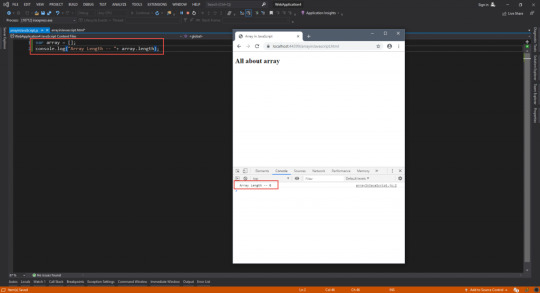
var array = new Array(100); console.log("Array Length -- "+ array.length);
In this example we only initialize the array and we are not adding any element in array. If you see the output you will see we initialize at 100 and length is also 100.
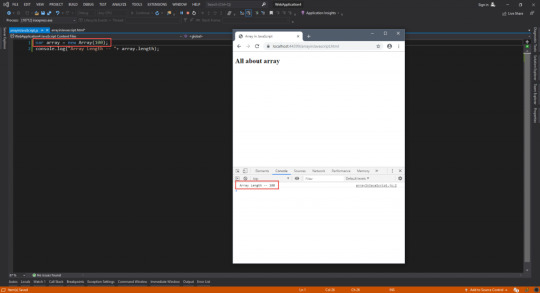
How to retrieve first and last element in array?
var array = [100,200,300] console.log("First Element -- " +array[0]); console.log("Last Element -- " + array[array.length-1]); document.write("Array Is " + array+"<br/>"); document.write("First Element -- " + array[0] + "<br/>"); document.write("Last Element -- " + array[array.length - 1] + "<br/>");

Different ways to declare Array in JavaScript
Declaring and populating array at the same time
Var array=[10,20,30]; Console.log(array);
Declaring array with array constructor: in this method we declare array with array constructor and then populate this array with the index. In JavaScript the array are not fixed length array type in other languages like c#,java this will grow dynamically even though they will declared with fixed length.
var constructor_array = new Array(2); constructor_array[0] = 10; constructor_array[1] = 20; constructor_array[3] = 30; console.log(constructor_array); console.log("Second Array Length - "+constructor_array.length);
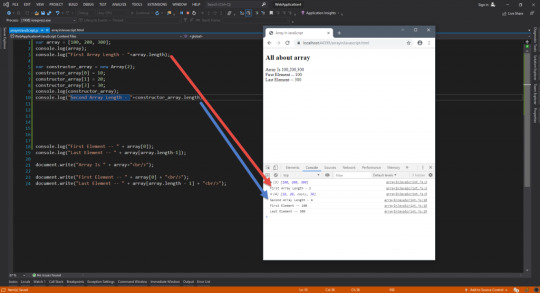
Push and Pop methods of JavaScript Array:
There are 2 methods to add element in array below is basic method where we can assign value to array index variable.
document.writeln("<br/>"); for (var i = 0; i < 10; i++) var val = (i + 1) * 2; myarray[i] = val;
In this code, we adding values from 0 to 9 index and always point to remember the array index start with 0.
To print these elements in array again we use an array with index to print like below.
for (var i = 0; i < 10; i++) document.writeln(myarray[i]); document.writeln("<br/>");
Below Is complete code to add elements in array and display on a page
var myarray = []; document.writeln("<H4> Showing Elements In Array Regular way</H4>"); document.writeln("<br/>"); for (var i = 0; i < 10; i++) var val = (i + 1) * 2; myarray[i] = val; document.writeln('myarray[' + i + '] =' + val); document.writeln("<br/>"); document.writeln("<H4> Showing Elements In Array</H4>"); document.writeln("<br/>"); for (var i = 0; i < 10; i++) document.writeln(myarray[i]); document.writeln("<br/>");
The output of code like below
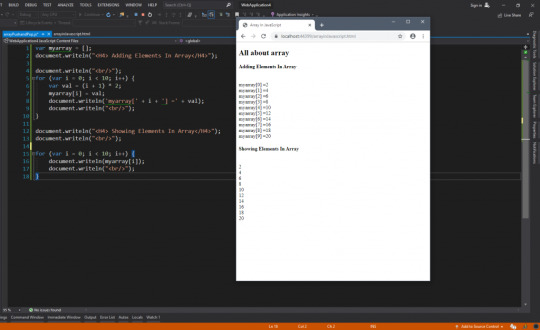
Now we will see the push and pop method using the same strategy
Push Method:
This method adds a new item to the end of array and using this length of the array is changed.
for (var i = 0; i < 10; i++) var val = (i + 1) * 2; myarray.push(val);
Pop Method:
It will remove the last element of an array and also this method change the length of an array.
for (var i = 0; i < 10; i++) document.writeln(myarray.pop(i));
Complete code is below
var myarray = []; document.writeln("<H4> Adding Elements In Array Push and Pop</H4>"); document.writeln("<br/>"); for (var i = 0; i < 10; i++) var val = (i + 1) * 2; myarray.push(val); document.writeln('myarray[' + i + '] =' + val); document.writeln("<br/>"); document.writeln("<H4> Showing Elements In Array</H4>"); document.writeln("<br/>"); for (var i = 0; i < 10; i++) document.writeln(myarray.pop(i)); document.writeln("<br/>");
The output of the above code is like below
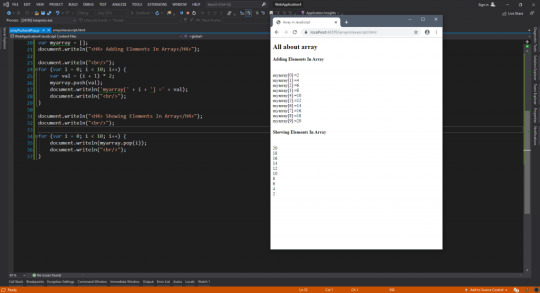
Shift and Unshift Method of an array in JavaScript
Unshift method:
This method is like a push method in the array means it adds a new item in array but the difference is that push method adds an element at last of an array and unshift adds elements at the beginning of an array.
var myarray = [4,3]; myarray.unshift(10); document.writeln('myarray[] =' + myarray); // myarray[] =10,4,3
Shift Method:
This method is alike of pop method but it removes the item from the beginning of an array .
var myarray = [10,4,3]; document.writeln(myarray.shift()); // 10
complete code of this
var myarray = [4,3]; document.writeln("<H4> Adding Elements In Array Using Shift and UnShift</H4>"); document.writeln("<br/>"); myarray.unshift(10); document.writeln('myarray[] =' + myarray); document.writeln("<br/>"); document.writeln("<H4> removing Elements In Array</H4>"); document.writeln("<br/>"); document.writeln(myarray.shift()); document.writeln("<br/>");
The output of above code is below

Mutator Methods in JavaScript:
In JavaScript there are several methods which can be used with array object in JavaScript. In which some methods modify the array object while another method did not modify that array object. The methods which modify the array object is mutator methods and which not modify the object is called non-mutator methods.
Examples of non-mutator methods below:
Contains, indexOf,Length
Examples of mutator methods like
Push
Pop
Unshift
Shift
Reverse
Sort
Splice
Sort Method of Array:
It will sorts elements in array. By default sort method sort the values by converting them into strings and then it will compare these strings.
This will work well for the string but not for numbers.
var array = ["Sagar", "Jaybhay", "Ram", "Lakhan"]; document.writeln("Before sort an array :==> "+array); array.sort(); document.writeln("<br/>"); document.writeln("<br/>"); document.writeln("After sort the array :==> "+array);
Output of above code is looks like below
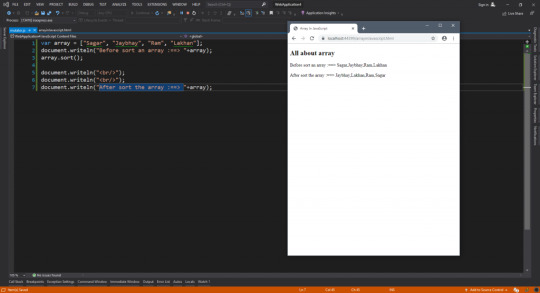
For Number see below code and output
var array = [10,1,12,11,3,2]; document.writeln("Before sort an array :==> " + array); array.sort(); document.writeln("<br/>"); document.writeln("<br/>"); document.writeln("After sort the array :==> " + array);
the output of this code
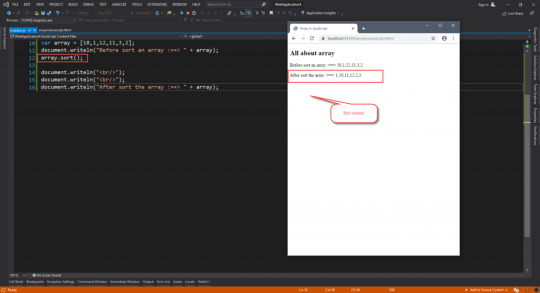
If you simply try to sort a numeric array using the sort() method it will not work, because the sort() method sorts the array elements alphabetically. But, you can still sort an array of integers correctly through utilizing a compare function, as shown in the following example:
var array = [10,1,12,11,3,2]; document.writeln("Before sort an array :==> " + array); array.sort(function(a, b) ); document.writeln("<br/>"); document.writeln("<br/>"); document.writeln("After sort the array :==> " + array);
the output of the above code is
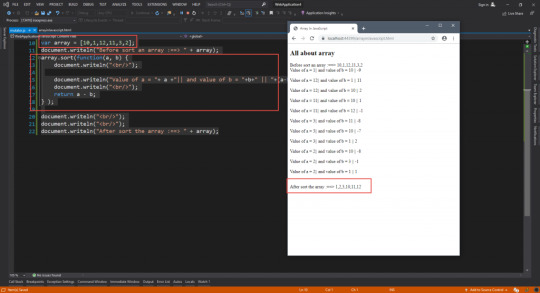
Now how compare function works in array sort function
Array.sort(function(a,b)return a-b)
The outcome of this inside function is only 3 types of output
Positive:- it means a is greater than b
Negative:- it means a is smaller than b
Zero:- it means both are equal
This will sort the array in ascending manner but if you want to sort array in descending manner you need to apply reverse function after that.
var array = [10, 1, 12, 11, 3, 2]; document.writeln("Before sort an array :==> " + array); array.sort(function (a, b) return a - b; ).reverse(); document.writeln("<br/>"); document.writeln("After sort the array :==> " + array);
or you can simply make a change in compare function like below change position of a and b in return statement.
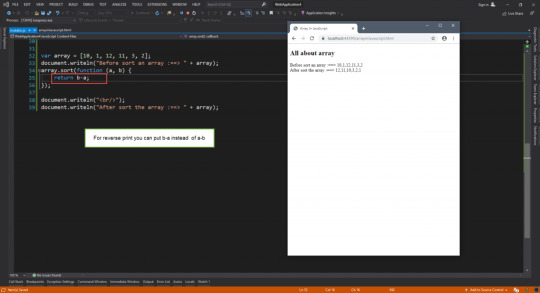
Methods in array elements
Methods Description concat() It returns a new array object that contains two or more merged arrays. copywithin It copies the part of the given array with its own elements and returns the modified array. every() It determines whether all the elements of an array are satisfying the provided function conditions. fill() It fills elements into an array with static values. filter() It returns the new array containing the elements that pass the provided function conditions. find() It returns the value of the first element in the given array that satisfies the specified condition. findIndex It returns the index value of the first element in the given array that satisfies the specified condition. forEach It invokes the provided function once for each element of an array. includes It checks whether the given array contains the specified element. indexOf It searches the specified element in the given array and returns the index of the first match. join() It joins the elements of an array as a string. lastIndexOf It searches the specified element in the given array and returns the index of the last match. map() It calls the specified function for every array element and returns the new array pop() It removes and returns the last element of an array. push() It adds one or more elements to the end of an array. reverse It reverses the elements of given array. shift() It removes and returns the first element of an array. slice() It returns a new array containing the copy of the part of the given array. sort() It returns the element of the given array in a sorted order. splice() It add/remove elements to/from the given array. unshift It adds one or more elements in the beginning of the given array.
Filter Method in JavaScript array:
The filter() method creates a new array and populates that array with all elements which meets the condition which is specified in callback function.
Synatx:
Array.filter(callbackfunction[,arg])
Callback function: It is required in filter function and it gets called for each element of array. If the function returns true, the element is kept else not.
Arg: it is optional and it is object to which this keyword is referred in callback function.
Filter mehod calls the callback function every time for each element in array. Suppose call back function returns false for every element in array then the length of an array is 0;
Callback Function Syntax:
Function callbackfunction(value,index,array)
Value- is value of array element
Index:- index position of elements in array
Array:- source array object
var array = [10, 20, 21, 11, 9, 122, 23, 31, 13, 221, 22, 321, 412, 123]; document.writeln("orignal array:- " + array); document.writeln("<br/>"); function isOdd(value,index,array) if (value % 2 != 0) return true; else return false; document.writeln("<br/>"); document.writeln("filtered array :-"+array.filter(isOdd));
the output of the above code is below image
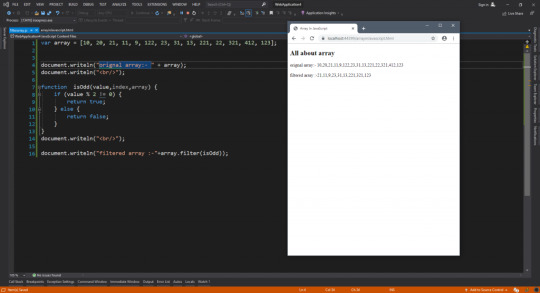
1 note
·
View note
Photo

Remove an item of #javascript array - ✂️It is good practice to use splice instead of delete because delete will leave "empty" where deleted item once was. But it is important to note that splice also mutates the array that calls it. So it should be used with caution. 🖐️ - 💬 Do you know of better ways to handle removing items from an array? Share them in the comment below
#100DaysofCode#coding#code#programming#programmer#javascript#developer#php#html#webdeveloper#webdevelopment#software#css#computerscience#webdev#java#coder#softwareengineering#html5#backend#python#programmers#rubyonrails#webdesign#frontend#asp#developers#development
12 notes
·
View notes